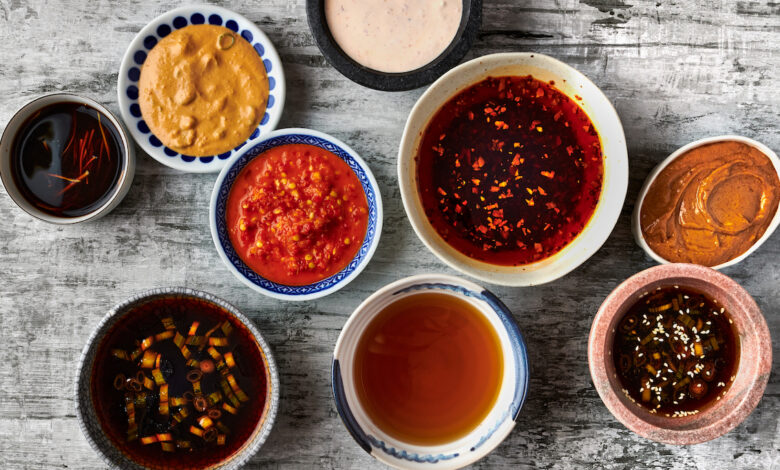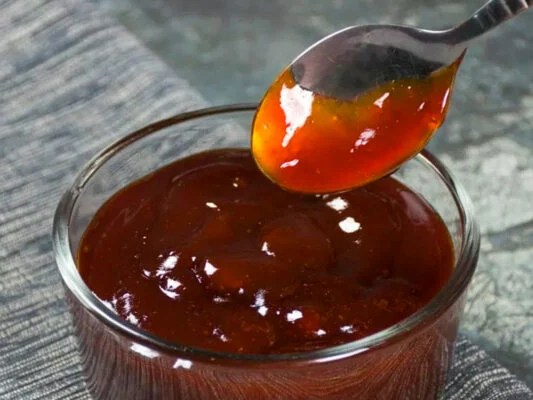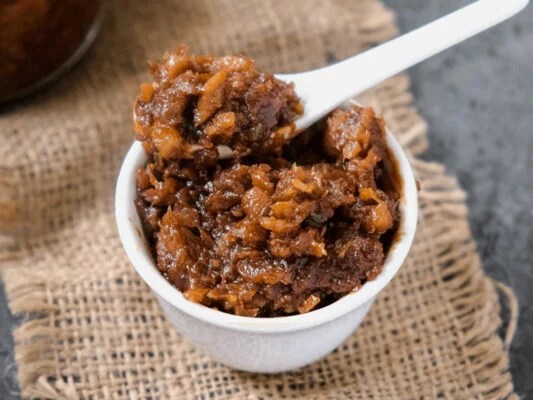Filipino Sauces And Condiments For Any Meal

As a Filipino, it’s safe to say many of us have a certain fondness for sawsawan, or dipping sauces.
Look at a typical Pinoy household or restaurant table, and you’re likely to find a variety of options for Filipino sauces, condiments and sides. If not, chances are high that the kitchen pantry is packed with ingredients that could be combined to make a from-scratch condiment concoction. (Think: vinegar, soy sauce, red chili, and the lime’s Filipino relative, calamansi. Yum.)
In This Article
Even if you opt to hold the sauce, sawsawan is readily available to ensure that the flavor of the dish is to your exact liking, which is reflective of Philippine food culture as a whole. Meals are often, if not always, viewed as a collaboration between the cook and the eater—and sawsawan bridges the gap between the taste of the chef and those eating the meal, giving new meaning to the phrase “sharing the table.”
“Serving sawsawan is an example of how intrinsically inclusive Filipino food culture is by accommodating everyone’s personal differences at the table,” says Jacqueline Chio-Lauri, anthologist, editor, and lead author of We Cook Filipino and The New Filipino Kitchen. “Some people might not want their food spicy, salty, or sweet, for example, but some might. All can partake of and enjoy the same dish because of the sawsawan.”
“Serving sawsawan is an example of how intrinsically inclusive Filipino food culture is by accommodating everyone’s personal differences at the table,” says Jacqueline Chio-Lauri, anthologist, editor, and author
What are typical Filipino sauces, condiments, and sauces?
Indeed, there is a sawsawan for every palate. There is sawsawan made from vinegar, for example, which is typically seasoned with spices and aromatics, to accompany meats like beef or pork, or one made sweet and sour and usually thickened with cornstarch for fried fish or lumpia Shanghai, a type of spring roll. “It’s also not uncommon for food to be served with more than one sawsawan to choose from—salty, sour, sweet, spicy, umami, or a combination of some of the flavors or all,” says Chio-Lauri.
As for condiments, you might find bagoong (shrimp paste) if you are served kare-kare, or oxtail stew. You’ll likely also taste umami-rich patis (fish sauce) when tasting sinigang, the classic sour and savory Filipino soup. There’s also banana ketchup—which, yes, is made from banana—and atchara (pickled vegetable relish), which is ideal alongside all proteins. If you’ve been lucky enough to have tried any of the above with a warm bowl of garlic fried rice, you know: There’s nothing better.
Simple, even humble, ingredients also have their place at the table. Consider calamansi—you can squeeze its juice straight onto the meal, or you can combine it with soy sauce, and if you want a kick, red chili slivers. Filipino sauces and condiments are, to borrow a term from the culture historian Doreen Fernandez, a “galaxy of flavor-adjusters” that allows for many permutations of a Filipino dish.
To note, many of these sauces and condiments aren’t only found in the Philippines, and many have their origins elsewhere. Take, for instance, shrimp paste and fish sauce, which are used in Vietnam, Thailand, and other Southeast Asian cuisines. However, they are nonetheless integral ingredients to Filipino food, which like the country itself, has many threads of influence. While they aren’t exclusive to the Philippines, they are what lends dishes their Filipino flair, and with their inclusion, it transforms, say, oxtail stew into kare-kare and soup into sinigang.
Whether or not a Filipino-inspired meal is on the menu, these condiments and sauce can also play well with dishes outside the realm of Philippine cuisine. You can purchase them ready-made from Asian supermarkets or online, or you can also make them at home with ingredients that you can find most anywhere.
5 recipes for Filipino sauces and condiments
Below, you’ll find five recipes for typical Filipino sauces, condiments, and sides—and while these recipes won’t lead you astray, there’s always the option to do it the Pinoy way and modify it to your liking. Registered dietitian nutritionist Gisela Bouvier, RDN also provides suggestions for those who want to substitute or subtract some of the ingredients used in the recipes, though many of the original recipes are nutrient-rich as is.
1. Garlic vinegar sawsawan

This piquant vinegar-based sawsawan or dipping sauce from the Naughty Kitchen calls for garlic, tomatoes, and red onion, garlic and onion seasonings, and a few cranks of black pepper—all ingredients that you might already have in your pantry. According to Bouvier, the vinegar is great for your gut, and the inclusion of tomatoes and red onion can add fiber to your plate. It contains low-sodium soy sauce too, which Bouvier adds, is ideal for those looking to lessen their salt intake. “It’s much lower in sodium compared to regular soy sauce, which has one teaspoon of about 290 milligrams or so of sodium,” she says. The sawsawan pairs well with meat and fish, says Chio-Lauri—its acidity is perfect for cutting through the richness of proteins.
Get the recipe: Filipino Garlic Vinegar Sauce
2. Sweet and sour sauce

This sweet and sour sauce from Taste Philippines is versatile, and it’s perfect for everything from spring rolls to fried fish, says Chio-Lauri. Pineapple juice provides a fruity sweetness, while white vinegar and soy sauce adds a savory tang. You can opt to modify the condiment to your liking, and for those who prefer it less sweet, Bouvier says you can reduce the amount of pineapple juice or brown sugar in the recipe to about an eighth of a cup or use ketchup with no added sugars.
Get the recipe: Filipino Sweet and Sour Sauce
3. Banana ketchup

Another one from Taste Philippines, this banana ketchup recipe captures the long-beloved flavor of the Filipino-made condiment. It’s sweet and tangy and warmed through with spices, like cayenne pepper, paprika, and cloves. As you might have surmised, bananas—particularly plantains—take center stage in this recipe. The bananas in the recipe contribute to fiber and potassium, says Bouvier, while the spices have anti-inflammatory properties, which make them great for gut health. It also contains vinegar, white onion, and garlic, plus tomato paste to give the condiment its rich red color. Bouvier adds that those who want to reduce the amount can opt to reduce the sugar content to about a quarter of a cup without taking away from the flavor of the recipe. Have the concoction with proteins, spring rolls, or omelets, says Chio-Lauri.
Get the recipe: Filipino Banana Ketchup
4. Vegan bagoong

This veganized version of bagoong from the Foodie Takes Flight uses oyster or shiitake mushrooms instead of fermented shrimp or fish, making it unique unto itself without drifting too far from the umami flavor that people have come to love about the condiment. “I love that it contains mushrooms,” says Bouvier. “Mushrooms are rich in vitamin D and vitamin B12.” There is also onion, ginger, and garlic in the mix, Thai red chilis for a kick, doenjang (Korean soybean paste) for some funk, and sugar to round out the flavor. According to Chio-Lauri, you can eat it with green mango slices as a snack, or take it from Jeeca, the owner of the Foodie Takes Flight, and spoon it into stir-fries.
Get the recipe: Vegan Filipino Bagoong
5. Atchara

This sweet-and-sour atchara recipe from Panlasang Pinoy stays true to the classic method of making the condiment, which typically uses vinegar spiked with sugar. You will also find colorful veggies—namely, carrots, red bell peppers, onions, garlic, and ginger—in the mix to amp up the flavor. Raisins also make an appearance, though you can opt to leave them out if you so please. Bouvier says that the process of fermenting papaya not only results in something delicious, it’s also good for you. “There’s research that says papaya is an excellent nutraceutical when you combine it with other therapies,” she says, citing one study conducted in 2022.
In addition, papaya itself is rich in antioxidants and when it’s fermented—as with most veggies—it can help feed the good bacteria in your gut. If you want it more sour than sweet, she also suggests reducing the amount of sugar to just three quarters of a cup. When it comes time to eat, Chio-Lauri says it plays well with grilled meats and fish or as a palate cleanser between savory courses.
Get the recipe: Atchara
Our editors independently select these products. Making a purchase through our links may earn Well+Good a commission.

